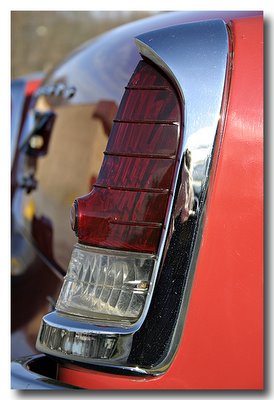Tuesday, February 28, 2006
Photoshop 80-20 Rule
Believe me, I'm no expert in Photoshop, but I've found that like many things in life, there is an 80-20 Rule that seems to apply. That is, you can get 80 percent of the benefit out of Photoshop by using 20 percent (or less) of its considerable array of tools.
Here is an example of that - Except for cropping, it's the first series of steps that I use on a .jpg file out of my camera. It only uses two tools, Levels and Unsharp Mask, and takes about two minutes if you do it slowly. But it really has improved the look of my images.
Now I happen to use Photoshop 4.0, a "ligher" version of Photoshop, but the same steps apply to honest-to-gosh Photoshop.
You can see the difference between the last two photos above. In the final photo, I applied Local Contrast Enhancement.
If you'd like to learn more about why this works, there is a good article here on the Luminous Landscape website.
Depending on what I'm going to do with the image (i.e., display it on the web or print it,) I usually do some "normal" sharpening as a final step, again using the Unsharp Mask.
I hope you find these few simple steps useful. I'll try to add some more Photoshop tips over the next few weeks. But if what I've shown you today isn't a great example of the 80-20 rule, I don't know what is.
Here is an example of that - Except for cropping, it's the first series of steps that I use on a .jpg file out of my camera. It only uses two tools, Levels and Unsharp Mask, and takes about two minutes if you do it slowly. But it really has improved the look of my images.
Now I happen to use Photoshop 4.0, a "ligher" version of Photoshop, but the same steps apply to honest-to-gosh Photoshop.
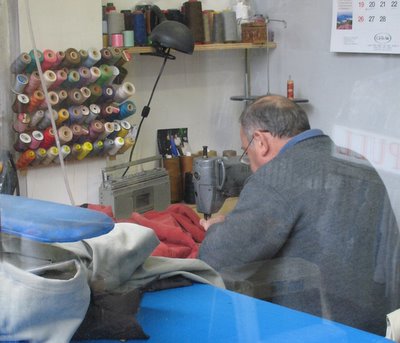 | Here is an image that, except for cropping, came right out of my Canon A620. I took it through the window of a tailor shop on Tenth Avenue in NYC on a cloudy day. The color balance is off - too blueish- and the image just has no snap - it's as dull as the weather outside. |
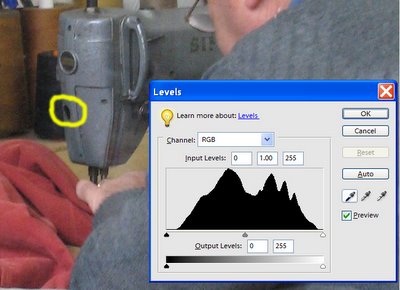 | The first thing I did was to bring up the Levels dialog (CTL-L). What I want to do now is key Photoshop into the blackest black in the image. To do that, I selected the Black Point eyedropper (the one on the left) and clicked it on that black patch (I think it's a hole) on the sewing machine. |
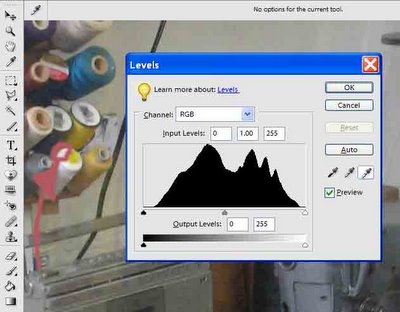 Next, with the Levels dialog still open, I picked the White Point eyedropper (the one on the right) and clicked it to what I wanted to be the whitest white in the photo - in this case, the top of a white spool of thread. Next, with the Levels dialog still open, I picked the White Point eyedropper (the one on the right) and clicked it to what I wanted to be the whitest white in the photo - in this case, the top of a white spool of thread. | |
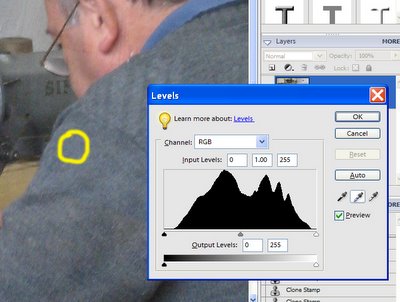 | Before I closed the Levels dialog, I picked the Gray Point eyedropper (the one in the middle) and clicked it on something that should be medium-gray, in this case, the tailor's sweater. |
 | I've repeated the original photo again here, so that you can easily compare it to the color-corrected image below. |
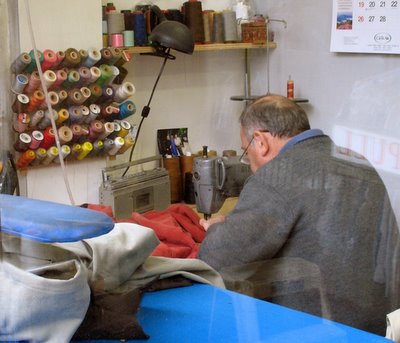 | Here is the color-corrected image that results after setting the black, white, and gray points and clicking OK in the Levels dialog. Compare this image to the original. Note the skin tones seem about right, and the overall bluish cast is gone. Also, the overall contrast is much better - it's as if you stripped a layer of dirty transparent film off of the photo. |
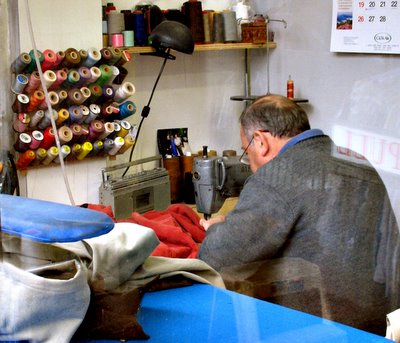 | At this point, I usually do something that I recently found on the excellent website Luminous Landscape - it's called Local Contrast Enhancement and it's dead simple, but I find it makes a big difference. Using the main menu, select on Filter/Sharpen/Unsharp Mask, which brings up the Unsharp Mask dialog. Select an Amount value of 20, a Radius value of 50, and a Threshold value of 0 (zero.) Before you close the dialog, click the Preview checkbox on and off a few times to see the effect. This technique adds a lot of snap to an image with almost none of the adverse affects of sharpening. |
You can see the difference between the last two photos above. In the final photo, I applied Local Contrast Enhancement.
If you'd like to learn more about why this works, there is a good article here on the Luminous Landscape website.
Depending on what I'm going to do with the image (i.e., display it on the web or print it,) I usually do some "normal" sharpening as a final step, again using the Unsharp Mask.
I hope you find these few simple steps useful. I'll try to add some more Photoshop tips over the next few weeks. But if what I've shown you today isn't a great example of the 80-20 rule, I don't know what is.
Monday, February 27, 2006
1955 Desoto
Saturday, February 25, 2006
Impulse Photography with the Canon A620
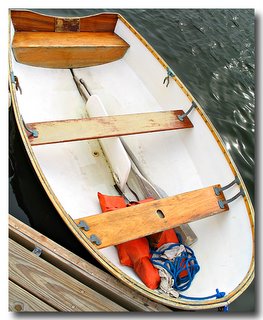 One of the great things about having a good-quality little camera is that you can do impulse photography. Sure, you've heard of impulse buying - well this is the same thing, but with taking photos. You can't impulse buy unless you have money, or more likely a credit card, on you. Likewise, you can't impulse-photograph unless you've got a camera on you.
One of the great things about having a good-quality little camera is that you can do impulse photography. Sure, you've heard of impulse buying - well this is the same thing, but with taking photos. You can't impulse buy unless you have money, or more likely a credit card, on you. Likewise, you can't impulse-photograph unless you've got a camera on you. And this has been the absolute best thing about the Canon A620, as far as I'm concerned. It's small enough that I take it with me pretty much everywhere, and when the mood strikes, I'm ready to shoot.
I was in Annapolis this morning - not scenic Annapolis, but a few blocks away in the nothing-doing-nothing-interesting part. After my business there was over, though, I remembered seeing a nice photo the other day taken at Acton Cove, which was only a few minutes drive away. Acton Cove is on picturesque Spa Creek, and I had my Canon A620 in my jacket pocket, so there you go.
No big deal - just a few photos on an impulse. Little time expended and little risk involved. If I end up with nothing good, who will know?
The little punt that was tied up at the small public dock at Acton Cove had a nice shape, and with a little Photoshop to compensate for the flat lighting, I ended up with a pretty nice impulse photo.
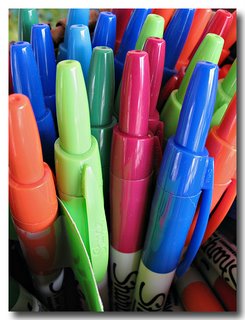 Before I headed home, I needed a sheet of black mat board, so I headed over to Art Things, which was right on the way. They always have some sort of nice display on their porch, and this time, what caught my eye was a container full of different-colored, retractable Sharpies.
Before I headed home, I needed a sheet of black mat board, so I headed over to Art Things, which was right on the way. They always have some sort of nice display on their porch, and this time, what caught my eye was a container full of different-colored, retractable Sharpies. Out came the Canon A620, and I took a quick photo. Whoops, I got that little shakey-camera icon on the LCD, and sure enough, the shot looked a little blurry. A few button presses, and I switched from ISO 50 to ISO 200. Picture taken, problem solved.
Impulse satisfied.
Tuesday, February 21, 2006
Drexel Road Trip
Last Friday was our Road Trip to Drexel. Ben is in his second year at community college, taking courses with an emphasis on computer programming and information systems. In looking for a place to complete his undergraduate degree, he became very interested in Drexel University in Philadelphia.
So Ben arranged for us to visit Drexel last Friday, and we were off before the sun came up. We took the obligatory Start of Road Trip pictures in our driveway at 6:30 AM Friday morning. As you can see from the first photo, Ben was totally fresh and alert as we prepared to roll out.

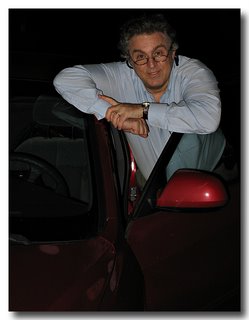
We had an appointment at 9:30 at the office of Drexel's College of Information Science and Technology, where we met Erin Stauffer, who is the Advising Manager at IST. Erin was just the right person to help Ben sort out which courses he can transfer credit as well as which courses would be good ones to take over the next few months at community collge (e.g. sociology, economics, etc - the non-core courses that would be less expensive to take and get out of the way locally. It looks like if Ben takes some summer courses and a normal load this fall, he can enter Drexel in January '07 as pretty close to a Junior. Ben's leaning towards the 5-year program, which would give him the opportunity to have two or possibly three 6-month co-op periods.
After lunch, we had a nice tour of campus. Drexel is part of what's called University City, which includes University of Pennsylvania and Temple. It's a large neighborhood with a funky college-town feel, but right across the Schuylkill River from downtown Philadelphia - within walking distance, actually, of the center of the city.
Besides the academic program, one of the things that attracted Ben to Drexel is that it's in a real city - big buildings, good public transit, the works.
Well, his application is in process, and it's now time for me to find out about financial aid... and maybe see about a second job as a greeter at Wal-Mart. Or maybe I can work alongside Ben at Starbucks.
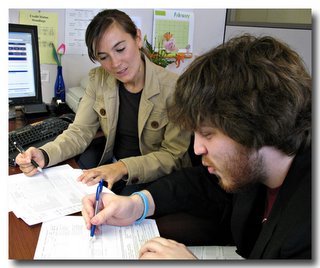
After our visit to Drexel, we headed north at about 4:30 PM ... destination: Secaucus.
The idea was to spend Saturday in New York City, and not wanting to spend New York City hotel prices, we had found, on Hotels.com, a ninety-nine dollar (taxes included!) room at Meadowlands Plaza Hotel in Secaucus. The room turned out to be just fine - a decent-sized, comfortable, no-smoking room with two queen beds with a great view of NJ Route 3 and a free breakfast - what's not to like?
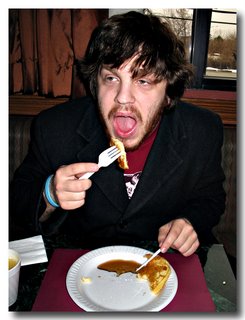 After getting to our room, we dumped our belongings and headed east on Route 3 for some dinner. In the cold, clear night air, we were treated to a spectacular view of the nightime Manhattan skyline just a few miles away. The Empire State Building was in red, white, and blue livery for Presidents' Day weekend, and the crown of the Chrysler Building blazed just over its shoulder. So joke all you want about Secaucus, but the view is amazing.
After getting to our room, we dumped our belongings and headed east on Route 3 for some dinner. In the cold, clear night air, we were treated to a spectacular view of the nightime Manhattan skyline just a few miles away. The Empire State Building was in red, white, and blue livery for Presidents' Day weekend, and the crown of the Chrysler Building blazed just over its shoulder. So joke all you want about Secaucus, but the view is amazing.
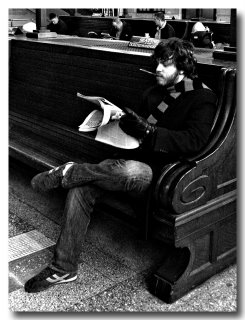 Saturday morning after breakfast, we drove the three miles to Hoboken, where we left the car for the day. Before catching the PATH train into the city, I took Ben into the Erie-Lackawanna Terminal, where we reprised my classic 1973 photo, Man on Bench. It really helps to schlep around your own photo subject.
Saturday morning after breakfast, we drove the three miles to Hoboken, where we left the car for the day. Before catching the PATH train into the city, I took Ben into the Erie-Lackawanna Terminal, where we reprised my classic 1973 photo, Man on Bench. It really helps to schlep around your own photo subject.
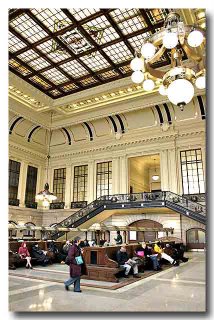 By the way, on the outside, the Terminal looks as decrepit as I remember it in my Stevens Tech days over thirty years ago. But walk through the doorways and you'll be surprised at finding one of those glorious turn-of-the-century public spaces - nicely maintained, too.
By the way, on the outside, the Terminal looks as decrepit as I remember it in my Stevens Tech days over thirty years ago. But walk through the doorways and you'll be surprised at finding one of those glorious turn-of-the-century public spaces - nicely maintained, too.
After our quick photo session at the Terminal, we walked next door to take the PATH into New York City. Now, Ben is a huge fan of the musical Rent, having seen it five times live and twice in the movies. He's always wanted to go to Life Café, a real-life restaurant that's prominently featured in the story. So we disembarked the PATH at 9th Street in The Village and went in search of Life Café.
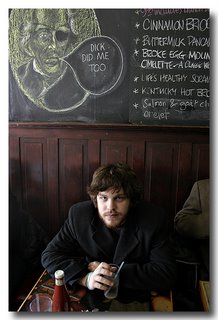 He had an address of 10th Street and Avenue B, for which I chided him that there was no Avenue B in Manhattan - he must be thinking about Brooklyn. But after much walking towards the East River, we did indeed come to Avenue A, then Avenue B and Life Café. Score one for the kid against the Old Guy Who Thinks He Knows All About Manhattan. So we had lunch at Life Café, commemorated with a photo of Ben on location.
He had an address of 10th Street and Avenue B, for which I chided him that there was no Avenue B in Manhattan - he must be thinking about Brooklyn. But after much walking towards the East River, we did indeed come to Avenue A, then Avenue B and Life Café. Score one for the kid against the Old Guy Who Thinks He Knows All About Manhattan. So we had lunch at Life Café, commemorated with a photo of Ben on location.
After lunch, it was time to head up to Central Park. A few weeks ago, I saw some amazing photographs of a new building, the Hearst Magazine Tower, that was nearing completion, and I wanted to take a look. So we schlepped many long avenue blocks back to Union Square and took the Q train to 7th and 57th Street.
 Coming out of the hole in the ground, we walked over to 8th Avenue, and... wow! This is a really impressive 600-foot building, not your typical glass-and-steel box. Well, glass-and-steel it is, but decidely different than anything else on the island.
Coming out of the hole in the ground, we walked over to 8th Avenue, and... wow! This is a really impressive 600-foot building, not your typical glass-and-steel box. Well, glass-and-steel it is, but decidely different than anything else on the island.
The 42-floor building is built on top of the original 1928 6-floor Hearst Building, a masonry art-deco design from 1928, which now acts as an architectural base for the modern tower
Rubbernecking at the Hearst for the next block or so, I suddenly heard Ben exclaim, "what is THAT!?"
It took me a second or so to see what he was seeing, as a huge, silvery tower emerged in my vision, sort of like a Klingon vessel coming uncloaked. The mirrored surface of the tower was doing such a good job of reflecting the adjacent blue sky and clouds that it almost blended in invisibly at first.
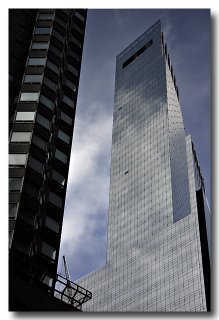 As we walked up to Columbus Circle, it tuned out that there was not one but TWO of these towers! This all turned out to be the Time-Warner Center, a spectacular commercial and residential development built in place of the boring old New York Coliseum.
As we walked up to Columbus Circle, it tuned out that there was not one but TWO of these towers! This all turned out to be the Time-Warner Center, a spectacular commercial and residential development built in place of the boring old New York Coliseum.
The towers stretch for 55 stories, topping out at 750 feet (229 meters.) They include a mix of residential apartments and rooms of the Mandarin Hotel, part of a luxury hotel chain. All apartments feature floor-to-ceiling windows (no thank you! I'm getting airsick just picturing it.)
So Mr. Knows Everything About Manhattan had been completely oblivious to all this spiffy new architecture happening on the West Side. Well, you learn something new every day. I took a few photos of Time-Warner, but this neighborhood, with all its new buildings, is a place I'll have to come back to again (preferably when it's considerably warmer than Saturday's 33 degrees) and take a lot more pictures.
 Ben and I crossed Columbus Circle and walked up Central Park West to the Dakota and took the Women's Gate entrance to the Park, walking by Strawberry Fields and over to Bethesda Terrace, our favorite part of the park.
Ben and I crossed Columbus Circle and walked up Central Park West to the Dakota and took the Women's Gate entrance to the Park, walking by Strawberry Fields and over to Bethesda Terrace, our favorite part of the park.
As we were getting really cold, we figured we had truly proven our love of New York and decided to finish our visit with a clockwise walk around the south end of the boat lake.
 We walked around the Loeb Boathouse (one of these days, after all these years, I'll go inside) and traversed the wonderful, huge rock that sits astride the lake on the west side of the boathouse. Then back onto a trail that leads along the shore of the lake, heading towards Bow Bridge.
We walked around the Loeb Boathouse (one of these days, after all these years, I'll go inside) and traversed the wonderful, huge rock that sits astride the lake on the west side of the boathouse. Then back onto a trail that leads along the shore of the lake, heading towards Bow Bridge.
As we stopped for a minute at a rustic little pavilllion, I glanced up at Bow Bridge and saw something that looked... unusual. Three people walked to the middle of the bridge, placed themselves in a line along one side, and lifted violins to their shoulders. "Hey, something's about to happen!" I called to Ben.
And something indeed did happen - one of those amazing New York moments. A young man and woman walked, arm-in-arm, onto the bridge, and the musicians started playing the theme from Love Story. We ran to the west end of the bridge and watched the man go down on one knee and propose. Wow. I got a little fahrklempt, I can tell you. I think I left a tear or two on the eyepiece of my camera as I took this photo.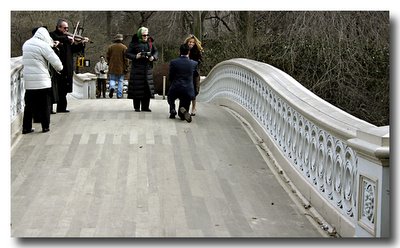 It was beautiful - a great ending to our visit to New York.
It was beautiful - a great ending to our visit to New York.
So Ben arranged for us to visit Drexel last Friday, and we were off before the sun came up. We took the obligatory Start of Road Trip pictures in our driveway at 6:30 AM Friday morning. As you can see from the first photo, Ben was totally fresh and alert as we prepared to roll out.


We had an appointment at 9:30 at the office of Drexel's College of Information Science and Technology, where we met Erin Stauffer, who is the Advising Manager at IST. Erin was just the right person to help Ben sort out which courses he can transfer credit as well as which courses would be good ones to take over the next few months at community collge (e.g. sociology, economics, etc - the non-core courses that would be less expensive to take and get out of the way locally. It looks like if Ben takes some summer courses and a normal load this fall, he can enter Drexel in January '07 as pretty close to a Junior. Ben's leaning towards the 5-year program, which would give him the opportunity to have two or possibly three 6-month co-op periods.
After lunch, we had a nice tour of campus. Drexel is part of what's called University City, which includes University of Pennsylvania and Temple. It's a large neighborhood with a funky college-town feel, but right across the Schuylkill River from downtown Philadelphia - within walking distance, actually, of the center of the city.
Besides the academic program, one of the things that attracted Ben to Drexel is that it's in a real city - big buildings, good public transit, the works.
Well, his application is in process, and it's now time for me to find out about financial aid... and maybe see about a second job as a greeter at Wal-Mart. Or maybe I can work alongside Ben at Starbucks.

After our visit to Drexel, we headed north at about 4:30 PM ... destination: Secaucus.
The idea was to spend Saturday in New York City, and not wanting to spend New York City hotel prices, we had found, on Hotels.com, a ninety-nine dollar (taxes included!) room at Meadowlands Plaza Hotel in Secaucus. The room turned out to be just fine - a decent-sized, comfortable, no-smoking room with two queen beds with a great view of NJ Route 3 and a free breakfast - what's not to like?
 After getting to our room, we dumped our belongings and headed east on Route 3 for some dinner. In the cold, clear night air, we were treated to a spectacular view of the nightime Manhattan skyline just a few miles away. The Empire State Building was in red, white, and blue livery for Presidents' Day weekend, and the crown of the Chrysler Building blazed just over its shoulder. So joke all you want about Secaucus, but the view is amazing.
After getting to our room, we dumped our belongings and headed east on Route 3 for some dinner. In the cold, clear night air, we were treated to a spectacular view of the nightime Manhattan skyline just a few miles away. The Empire State Building was in red, white, and blue livery for Presidents' Day weekend, and the crown of the Chrysler Building blazed just over its shoulder. So joke all you want about Secaucus, but the view is amazing.  Saturday morning after breakfast, we drove the three miles to Hoboken, where we left the car for the day. Before catching the PATH train into the city, I took Ben into the Erie-Lackawanna Terminal, where we reprised my classic 1973 photo, Man on Bench. It really helps to schlep around your own photo subject.
Saturday morning after breakfast, we drove the three miles to Hoboken, where we left the car for the day. Before catching the PATH train into the city, I took Ben into the Erie-Lackawanna Terminal, where we reprised my classic 1973 photo, Man on Bench. It really helps to schlep around your own photo subject. By the way, on the outside, the Terminal looks as decrepit as I remember it in my Stevens Tech days over thirty years ago. But walk through the doorways and you'll be surprised at finding one of those glorious turn-of-the-century public spaces - nicely maintained, too.
By the way, on the outside, the Terminal looks as decrepit as I remember it in my Stevens Tech days over thirty years ago. But walk through the doorways and you'll be surprised at finding one of those glorious turn-of-the-century public spaces - nicely maintained, too.After our quick photo session at the Terminal, we walked next door to take the PATH into New York City. Now, Ben is a huge fan of the musical Rent, having seen it five times live and twice in the movies. He's always wanted to go to Life Café, a real-life restaurant that's prominently featured in the story. So we disembarked the PATH at 9th Street in The Village and went in search of Life Café.
 He had an address of 10th Street and Avenue B, for which I chided him that there was no Avenue B in Manhattan - he must be thinking about Brooklyn. But after much walking towards the East River, we did indeed come to Avenue A, then Avenue B and Life Café. Score one for the kid against the Old Guy Who Thinks He Knows All About Manhattan. So we had lunch at Life Café, commemorated with a photo of Ben on location.
He had an address of 10th Street and Avenue B, for which I chided him that there was no Avenue B in Manhattan - he must be thinking about Brooklyn. But after much walking towards the East River, we did indeed come to Avenue A, then Avenue B and Life Café. Score one for the kid against the Old Guy Who Thinks He Knows All About Manhattan. So we had lunch at Life Café, commemorated with a photo of Ben on location.After lunch, it was time to head up to Central Park. A few weeks ago, I saw some amazing photographs of a new building, the Hearst Magazine Tower, that was nearing completion, and I wanted to take a look. So we schlepped many long avenue blocks back to Union Square and took the Q train to 7th and 57th Street.
 Coming out of the hole in the ground, we walked over to 8th Avenue, and... wow! This is a really impressive 600-foot building, not your typical glass-and-steel box. Well, glass-and-steel it is, but decidely different than anything else on the island.
Coming out of the hole in the ground, we walked over to 8th Avenue, and... wow! This is a really impressive 600-foot building, not your typical glass-and-steel box. Well, glass-and-steel it is, but decidely different than anything else on the island. The 42-floor building is built on top of the original 1928 6-floor Hearst Building, a masonry art-deco design from 1928, which now acts as an architectural base for the modern tower
Rubbernecking at the Hearst for the next block or so, I suddenly heard Ben exclaim, "what is THAT!?"
It took me a second or so to see what he was seeing, as a huge, silvery tower emerged in my vision, sort of like a Klingon vessel coming uncloaked. The mirrored surface of the tower was doing such a good job of reflecting the adjacent blue sky and clouds that it almost blended in invisibly at first.
 As we walked up to Columbus Circle, it tuned out that there was not one but TWO of these towers! This all turned out to be the Time-Warner Center, a spectacular commercial and residential development built in place of the boring old New York Coliseum.
As we walked up to Columbus Circle, it tuned out that there was not one but TWO of these towers! This all turned out to be the Time-Warner Center, a spectacular commercial and residential development built in place of the boring old New York Coliseum. The towers stretch for 55 stories, topping out at 750 feet (229 meters.) They include a mix of residential apartments and rooms of the Mandarin Hotel, part of a luxury hotel chain. All apartments feature floor-to-ceiling windows (no thank you! I'm getting airsick just picturing it.)
So Mr. Knows Everything About Manhattan had been completely oblivious to all this spiffy new architecture happening on the West Side. Well, you learn something new every day. I took a few photos of Time-Warner, but this neighborhood, with all its new buildings, is a place I'll have to come back to again (preferably when it's considerably warmer than Saturday's 33 degrees) and take a lot more pictures.
 Ben and I crossed Columbus Circle and walked up Central Park West to the Dakota and took the Women's Gate entrance to the Park, walking by Strawberry Fields and over to Bethesda Terrace, our favorite part of the park.
Ben and I crossed Columbus Circle and walked up Central Park West to the Dakota and took the Women's Gate entrance to the Park, walking by Strawberry Fields and over to Bethesda Terrace, our favorite part of the park. As we were getting really cold, we figured we had truly proven our love of New York and decided to finish our visit with a clockwise walk around the south end of the boat lake.
 We walked around the Loeb Boathouse (one of these days, after all these years, I'll go inside) and traversed the wonderful, huge rock that sits astride the lake on the west side of the boathouse. Then back onto a trail that leads along the shore of the lake, heading towards Bow Bridge.
We walked around the Loeb Boathouse (one of these days, after all these years, I'll go inside) and traversed the wonderful, huge rock that sits astride the lake on the west side of the boathouse. Then back onto a trail that leads along the shore of the lake, heading towards Bow Bridge. As we stopped for a minute at a rustic little pavilllion, I glanced up at Bow Bridge and saw something that looked... unusual. Three people walked to the middle of the bridge, placed themselves in a line along one side, and lifted violins to their shoulders. "Hey, something's about to happen!" I called to Ben.
And something indeed did happen - one of those amazing New York moments. A young man and woman walked, arm-in-arm, onto the bridge, and the musicians started playing the theme from Love Story. We ran to the west end of the bridge and watched the man go down on one knee and propose. Wow. I got a little fahrklempt, I can tell you. I think I left a tear or two on the eyepiece of my camera as I took this photo.
 It was beautiful - a great ending to our visit to New York.
It was beautiful - a great ending to our visit to New York.Thursday, February 16, 2006
Family Photos
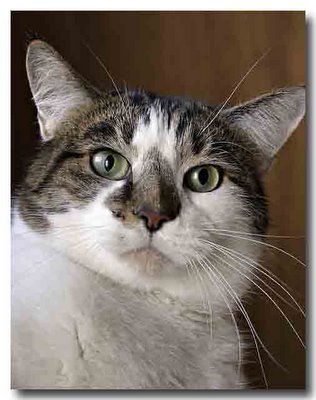 I don't take nearly enough family photos. Is that a typical shortcoming of an artsy-fartsy photographer?
I don't take nearly enough family photos. Is that a typical shortcoming of an artsy-fartsy photographer?Speaking of family, though, I was at my brother's a few weeks ago, and my sister-in-law Janice asked to take some photos of their two cats, Target and Mittens.
This is hard stuff. Years ago, between college semesters, I was the local "photographer to the dogs," but dogs are very easy compared to cats. Now I have a real appreciation for good cat photos.
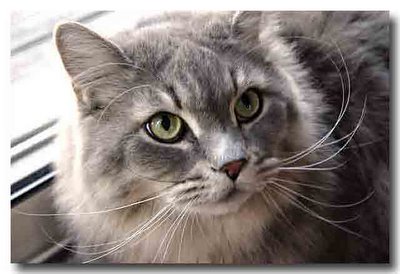 Tomorrow, Ben and I are driving to Drexel University in Philadelphia. Ben has appointments with admissions and the computers science department. Now in his second year at community college (a true educational bargain!) he's very interested in continuing at Drexel next year.
Tomorrow, Ben and I are driving to Drexel University in Philadelphia. Ben has appointments with admissions and the computers science department. Now in his second year at community college (a true educational bargain!) he's very interested in continuing at Drexel next year. After our visit to Drexel, we'll have dinner and then head up the Jersey Turnpike to stay at a motel overnight, then off we go Saturday morning to park in Hoboken and spend the day in New York CIty. Photo opportunities!
Friday, February 10, 2006
Overlooked Iconography
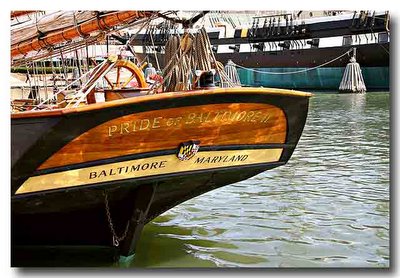 Not much time over the past week for making new photos or writing anything too profound, so I'm falling back on the old tried-and-true routine of spelunking among old CD-R's for photos I might have overlooked.
Not much time over the past week for making new photos or writing anything too profound, so I'm falling back on the old tried-and-true routine of spelunking among old CD-R's for photos I might have overlooked.And what do you know - I found one from Baltimore Commie Camera Day 2004, which took place at the Inner Harbor in April of that year. The overlooked image was actually the very first one I took that morning, kind of a warm-up shot in anticipation of the serious photo action upon meeting up with my SovCam Comrades.
But as I looked over the old images, I realized that what I had was a decent photo of the Pride of Baltimore II, a replica of an 1800's Baltimore Clipper built to commemorate Maryland's historic role in shipbuilding. Pride II sails frequently to the four corners of the earth and serves as a goodwill ambassador for Maryland and the Port of Baltimore.
So what found is an iconic image that says, "Baltimore," and one that might just sell.
Oh, and it doesn't hurt that in the background is the frigateUSS Constellation, a Baltimore landmark.
Wednesday, February 08, 2006
My Camera History, Part VI
 In 1979, I mentioned to my friend Mike Tzougrakis that I wanted to get a small camera for Sandy, then my fiancée. After all, it just wouldn't do for her to keep using a Kodak 110 camera.
In 1979, I mentioned to my friend Mike Tzougrakis that I wanted to get a small camera for Sandy, then my fiancée. After all, it just wouldn't do for her to keep using a Kodak 110 camera. Mike said, "I have just what you need," and showed me a little Miranda rangefinder, which I ended up buying from him. I gave it to Sandy, and a short while after we were married, after I had sold all my other camera equipment, it became the only camera in our family for a while. By then I had gotten rid of the Minolta SLRs, finally, all my Leica equipment.
The Miranda Sensoret was acutally a nice little camera and served us well. Pretty spiffy, too - unlike the photo above, ours was a "professional black" model. For Sandy, it was great, since it had a programmed shutter, so other than focusing, there was nothing else to do. And focusing was easy with a good, clear coincident-image rangerfinder.
The little 38mm f/2.8 was sharp enough, and overall, the camera was a good performer. For it's time, it was more or less in the same league as the Konica C35 and Minolta Hi-Matic F - all good cameras. Interestingly, the Sensoret was the only rangefinder ever made by Miranda, a Japanese camera company that otherwise was born and died (1953-1978) making only SLRs
Most important to me, this is the camera that took most of the pictures of our first year with our first child, Leah, born in 1982.
Friday, February 03, 2006
The Jew In The Lotus
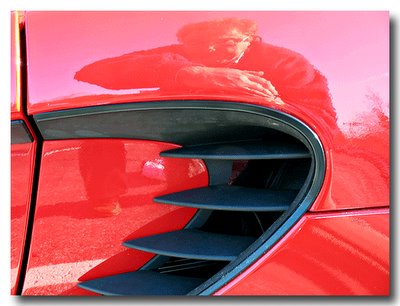 Yesterday as I arrived at the parking lot at work, I noticed an unusual little red car parked away from everyone else. Not knowing much about fancy cars (I drive a Hyundai, after all,) I had to get right up and read the emblem to learn that it was a Lotus.
Yesterday as I arrived at the parking lot at work, I noticed an unusual little red car parked away from everyone else. Not knowing much about fancy cars (I drive a Hyundai, after all,) I had to get right up and read the emblem to learn that it was a Lotus.Well, a nice red car with interesting lines on a sunny day - why not take a few photos? I pulled my Canon A620 out of my satchel and started to snap. Now I know a good swoosh when I see one, and I liked the black swoosh design on the door, so that's what I concentrated on.
Today, as I looked at the photos on my computer, I realized that the last one, the real close-up, had my reflection in it. The caption for that photo popped right into my head.
The Jew In the Lotus
Clever as that may seem, the credit goes to writer Roger Kamenetz, author of The Jew In the Lotus, a fascinating book I read over 10 years ago. Kamenetz had been invited to attend and chronicle an historical meeting in Dharamsala between a delegation of American Jews and a group of Tibetan Bhuddists, including the Dalai Lama.
The title is a play on words, a reverent pun of a mantra used in the Lama's tradition - om mani padme hum, "the Jewel in the Lotus."
I remember the scene in the film where Kamenetz revisits Dharamsala after the book was published. He presented a copy to the Dalai Lama, who read the title aloud and for a second looked slightly puzzled.
Then his face suddenly brightened, and breaking out laughing, he said, "The Jew in the Lotus! That's very good!"
Thursday, February 02, 2006
My Camera History, Part V
This post will probably be the shortest one in this series, because for me, the cameras were forgettable.
After my OM-1 outfit was stolen, I got a very nice settlement from the insurance company, enough to replace everything fully. So I set out to buy pretty much the same thing: two camera bodies, a 24mm wide angle, a zoom in the 75-100mm range, and maybe a power winder.
At that time, the Minolta XD-11 had just come out, creating quite a stir in the amateur photography world. It was a compact camera, about the size of the OM-1, but with exposure automation - both shutter priority and aperture priority, selectable. Of course, you could also turn off automation and use it as a match-needle (match-diode, actually, the age of electronic Wunderplastik cameras had just begun.)
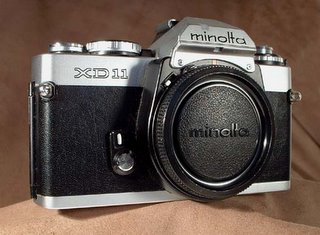
So I went that route, buying an XD-11, along with an XG-7 as a second body. The XG-7 was similar, but with only aperture-priority automation plus manual operation. I also got a 24mm Rokkor lens and a zoom.
But I just didn't care for these cameras - I don't know exactly why. I think they just didn't feel as good as the OM-1's did to me. I know that technically speaking, there was nothing wrong with either camera or the lenses. Just didn't like them. I probably should have stuck with OM-1's, or maybe even an OM-1 plus an OM-2 body (the OM-2 had the option of aperture-priority automation, but in essentially the same mechanical body as the OM-1.)
After a little more than a year, I sold all the Minolta equipment for $600, a considerable loss, and I have no photos that have survived from these cameras. Most of the pictures I took during that year were with my Leicas and the Minolta CL.
After my OM-1 outfit was stolen, I got a very nice settlement from the insurance company, enough to replace everything fully. So I set out to buy pretty much the same thing: two camera bodies, a 24mm wide angle, a zoom in the 75-100mm range, and maybe a power winder.
At that time, the Minolta XD-11 had just come out, creating quite a stir in the amateur photography world. It was a compact camera, about the size of the OM-1, but with exposure automation - both shutter priority and aperture priority, selectable. Of course, you could also turn off automation and use it as a match-needle (match-diode, actually, the age of electronic Wunderplastik cameras had just begun.)

So I went that route, buying an XD-11, along with an XG-7 as a second body. The XG-7 was similar, but with only aperture-priority automation plus manual operation. I also got a 24mm Rokkor lens and a zoom.
But I just didn't care for these cameras - I don't know exactly why. I think they just didn't feel as good as the OM-1's did to me. I know that technically speaking, there was nothing wrong with either camera or the lenses. Just didn't like them. I probably should have stuck with OM-1's, or maybe even an OM-1 plus an OM-2 body (the OM-2 had the option of aperture-priority automation, but in essentially the same mechanical body as the OM-1.)
After a little more than a year, I sold all the Minolta equipment for $600, a considerable loss, and I have no photos that have survived from these cameras. Most of the pictures I took during that year were with my Leicas and the Minolta CL.
Wednesday, February 01, 2006
My Camera History, Part IV
Just shoot me. Kill me now...
... because I once had a Leica M3, a beautiful, clean one at that, and then sold it two years later.

I bought the M3 DS (double-stroke) in 1978 or 1979, I can't remember exactly when - I guess it's just too painful - at my favorite little camera shop, Olden Camera, just off Herald Square. I think it was something like $350 or $380, and that included a screw-mount-to-M-mount adaptor for my 50mm collapsible Summicron. I don't think I could touch that same camera today for under a thousand dollars. Maybe I shoulda invested in Leicas instead of the stock market.
 The funny thing is, as beautiful and precise and fondle-able that camera was, I just don't remember taking a whole lot of pictures with it. I don't think I have a single photo that I can put my hands on right now that I could definitely say was taken with the M3. Don't ask.
The funny thing is, as beautiful and precise and fondle-able that camera was, I just don't remember taking a whole lot of pictures with it. I don't think I have a single photo that I can put my hands on right now that I could definitely say was taken with the M3. Don't ask.
But it gets worse. I also bought a Minolta CL in 1979. The Leica CL and Minolta CL were compact M-mount rangerfinders made by Minolta and jointly designed by Leitz and Minolta. Sort of like a Buick and an Oldsmobile. Anyway, the CL was a truly amazing design - it was even smaller than my Leica IIIc, and yet totally modern and innovative, sporting a throught-the-lens spotmeter - I think that was a first for an interchangeable-lens rangefinder.
The CL came with a very sharp 40mm f/2 Rokkor (the Leitz version were called Summicron), and it was capable of mounting other Leica lenses, either M-mount or using an adaptor, old screw-mount lenses.
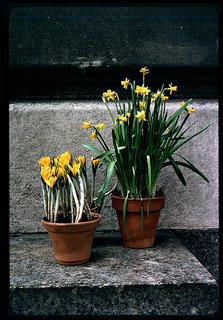 I did use the CL more than the M3, but still not an awful lot compared to my earlier cameras and the Leica IIIc that I still had. At least, compared to the M3, I have one or two yellow slide boxes that are marked "CL" to show for it.
I did use the CL more than the M3, but still not an awful lot compared to my earlier cameras and the Leica IIIc that I still had. At least, compared to the M3, I have one or two yellow slide boxes that are marked "CL" to show for it.
My Leica era came to an end by 1981, by which time I had sold all three cameras.
I know, I know.
... because I once had a Leica M3, a beautiful, clean one at that, and then sold it two years later.

I bought the M3 DS (double-stroke) in 1978 or 1979, I can't remember exactly when - I guess it's just too painful - at my favorite little camera shop, Olden Camera, just off Herald Square. I think it was something like $350 or $380, and that included a screw-mount-to-M-mount adaptor for my 50mm collapsible Summicron. I don't think I could touch that same camera today for under a thousand dollars. Maybe I shoulda invested in Leicas instead of the stock market.
 The funny thing is, as beautiful and precise and fondle-able that camera was, I just don't remember taking a whole lot of pictures with it. I don't think I have a single photo that I can put my hands on right now that I could definitely say was taken with the M3. Don't ask.
The funny thing is, as beautiful and precise and fondle-able that camera was, I just don't remember taking a whole lot of pictures with it. I don't think I have a single photo that I can put my hands on right now that I could definitely say was taken with the M3. Don't ask.But it gets worse. I also bought a Minolta CL in 1979. The Leica CL and Minolta CL were compact M-mount rangerfinders made by Minolta and jointly designed by Leitz and Minolta. Sort of like a Buick and an Oldsmobile. Anyway, the CL was a truly amazing design - it was even smaller than my Leica IIIc, and yet totally modern and innovative, sporting a throught-the-lens spotmeter - I think that was a first for an interchangeable-lens rangefinder.
The CL came with a very sharp 40mm f/2 Rokkor (the Leitz version were called Summicron), and it was capable of mounting other Leica lenses, either M-mount or using an adaptor, old screw-mount lenses.
 I did use the CL more than the M3, but still not an awful lot compared to my earlier cameras and the Leica IIIc that I still had. At least, compared to the M3, I have one or two yellow slide boxes that are marked "CL" to show for it.
I did use the CL more than the M3, but still not an awful lot compared to my earlier cameras and the Leica IIIc that I still had. At least, compared to the M3, I have one or two yellow slide boxes that are marked "CL" to show for it.My Leica era came to an end by 1981, by which time I had sold all three cameras.
I know, I know.
My Camera History, Part III
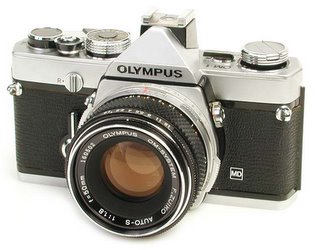 As I began to use my Leica IIIc alongside my Nikon F during the middle '70's, I started to wonder about a more compact SLR. Here again, my friend Rich Schnabolk, the former Kowa owner, influenced me. Rich had started using an Olympus OM-1, and I was very impressed with how compact it was.
As I began to use my Leica IIIc alongside my Nikon F during the middle '70's, I started to wonder about a more compact SLR. Here again, my friend Rich Schnabolk, the former Kowa owner, influenced me. Rich had started using an Olympus OM-1, and I was very impressed with how compact it was.In 1977, I sold my Nikon F and used the proceeds to by my first OM-1 body and 50mm f/1.8 Zuiko lens.
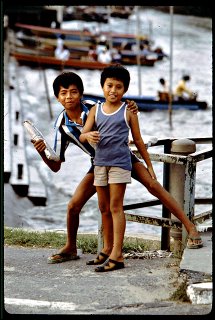 Though smaller than any other SLR at the time, the OM-1 was full-featured and even a "system" camera - with a full range of lenses and accessories available. The little camera had a very solid feel, and surprisingly, a brighter and larger-appearing viewfinder than contemporary cameras.
Though smaller than any other SLR at the time, the OM-1 was full-featured and even a "system" camera - with a full range of lenses and accessories available. The little camera had a very solid feel, and surprisingly, a brighter and larger-appearing viewfinder than contemporary cameras.I was very taken with the OM-1, and in short order, bought a second body (black "professional" model, no less!) and a 24mm f/2.8 Zuiko lens.
In October 1977, on a business trip to Brunei for GE, our team stopped on the way over in Hong Kong. One of my collegues, a fellow photographer, joined me in an expedition to the photos shops of Kowloon on a mission to by some equipment. I left Hong Kong with a nifty Zuiko 75-150mm zoom and a power winder. So by this point, I had a nice little outfit of OM-1 equipment to work with - the first time I had anything more than a camera and its normal lens.
Momma Don't Take My Kodachrome Away...
With the Leica, I shot mostly black-and-white film. But with the OM-1's, I went after slides in a big way. Now that I had a range of lenses and two cameras, I felt, I could crop my shots in-camera.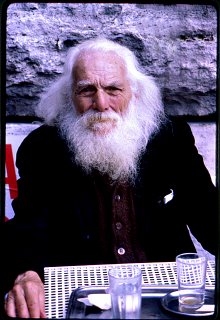 In my job at GE in those years, I travelled extensively overseas, and the little OM-1 outfit proved to be a good fit for travelling and travel photography. The kit came with me on trips to Frankfurt, Zurich, Milan, Paris, Jeddah, and of course, Rome.
In my job at GE in those years, I travelled extensively overseas, and the little OM-1 outfit proved to be a good fit for travelling and travel photography. The kit came with me on trips to Frankfurt, Zurich, Milan, Paris, Jeddah, and of course, Rome.Because I was in Rome on several occasions for several days each, I eventually accumulated an especially big stack of yellow boxes of Ektachromes and Kodachromes of the Eternal City, shot with the OM-1's. My friend and GE collegue Mike Tzougrakis pointed out on more than one occassion as he stood near me hearing the weeeee-chunk! weeeee-chunk! of my power winder that that sound was music to Kodak's ears.
Alas, my OM-1 period was too short... and not because I necessarily wanted it that way. In December 1978, I came home to my apartment from work one evening, and after about a half-hour, noticed that the venetian blinds on one of the two windows was rattling in the breeze.
 Breeze? In December? Before I even looked at the window, I shot a glance to the corner of the room where I always left my camera bag... and it was gone!
Breeze? In December? Before I even looked at the window, I shot a glance to the corner of the room where I always left my camera bag... and it was gone!And sure enough, the window leading to the fire escape was open - I wuz robbed! A few minutes later I heard a shout from the apartment upstairs and a commotion in the hall. Whoever had hit my place also hit most everyone on the five floors on that side of the building.
Besides my entire OM-1 ensemble (it was all in that one bag,) the thief also made off with an old Crown Graphic 4x5 press camera and, sad to say, that Dad's Kodak Retina, the camera with which I had learned photography.
But all was not lost. Still sitting in a drawer was my Leica IIIc with its Summicron lens, along with a Weston Master V light meter.
In fact, almost nothing was truly lost - the cameras were all on a rider to my renter's insurance policy. I wasn't very careful with just about anything in those days except my cameras.
